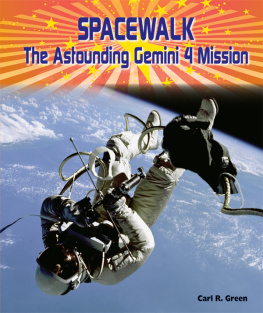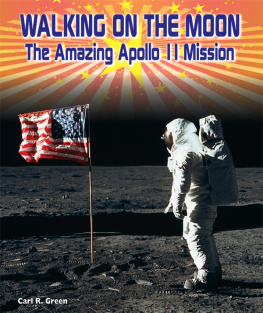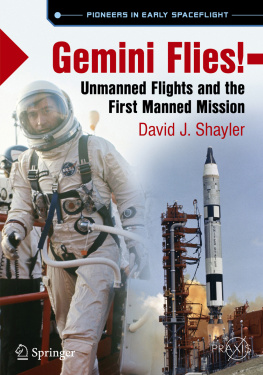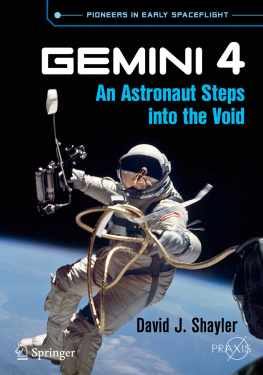Taking "Big Steps" in Space!
Gemini 4 pilot Ed White could see Hawaii, California, Texas, and Florida. Millions of Americans had seen these places before, but White had a unique view. He looked at them while walking in space! One hundred miles above Earth and moving freely outside the Gemini 4 spacecraft, White saw these states as tiny stepping stones. The first American spacewalk was a monumental achievement, and it helped push the space program toward its ultimate goal of landing men on the Moon. From the brave astronauts to the technology that made it possible, author Carl R. Green explores the astounding Gemini 4 mission.
About the Author
Carl R. Green brings an abiding commitment to young readers to his writing. Alone and in tandem with William R. Sanford, he is the author of more than 150 books.


Image Credit: NASA Johnson Space Center
The year was 1965. It was the era of the Cold War, a time of intense rivalry between the United States and the Soviet Union. Which system of government would triumph, democracy or communism? In the military realm, the race was on to build more destructive weapons. In science, the challenge lay in blazing new trails in space. The Russians had jumped out in front by launching the first space satellite in 1957. Eight years later, the United States still was playing catch-up.
On June 3, 1965, a Titan II rocket blasted the Gemini 4 spacecraft into orbit. The ship carried two American astronauts: Command Pilot Jim McDivitt and Pilot Ed White. Ten weeks earlier, the Russian cosmonaut Alexei Leonov had made headlines by taking a ten-minute walk in space. Now, as McDivitt ran down the checklist, White was suiting up for his own spacewalk. His bosses at NASA (the National Aeronautics and Space Administration) called it an EVA (Extra Vehicular Activity). Each piece of equipment had been checked and rechecked in the lab. Now, the real test was at hand. Would Whites suit and tether safeguard him while he roamed the cold vacuum of space?
After assembling a 7.5-pound (3.4 kilograms) gas gun, White hooked up his 25-foot (7.6 meters) gold-braided tether. Along with providing oxygen, the tether kept him moored to the ship. Next came the emergency oxygen pack. When he finished, McDivitt told Mission Control that all systems checked out. From Houston, the reply flashed back. CapCom (the Capsule Command Communicator) told White, Were ready to have you get out whenever youre ready.
The astronauts quickly reduced the cabin pressure to zero. White then stood up in his seat and tried to pop the hatchonly to find that it was stuck. When the balky cover did fly open, he had to hold on tight to keep it from banging against the hull. Now, with his head poking out of the hatch, White set up a camera to record his spacewalk. As the world waited, he double-checked his work. I wanted to make sure I didnt leave the lens cap on, he said later.
Twelve minutes after popping the hatch, White floated free of the ship. With his eyes shielded from glare by a gold-coated faceplate, he set out to explore his silent world. A pull on the tether sent him looping toward the rear of the ship. A burst from the gas gun brought him back when he came too close to the ships thrusters. For one confusing moment, White felt as though he was moving in all directions at once. Another burst from the gas gun put him into a controlled turn, and a second jolt stopped the movement. At that point, to the spacewalkers dismay, the gun ran out of gas.
Like his ship, the human satellite sped through space at 17,500 miles (28,158 kilometers) per hour. As he drifted, White described the dazzling earthscape below him. In Houston, Mission Control relayed his words around the globe. Right now Im standing on my head and Im looking down... and Im going into a slow rotation, he told his spellbound listeners. There is absolutely no disorientation associated with it. I can sit out here and see the whole California coast.

Image Credit: NASA Kennedy Space Center
Ed White (left) and Jim McDivitt posed for this photo just before the launch of Gemini 4. McDivitt piloted the spacecraft into orbit, and White became the first American to walk in space.

Image Credit: James McDivitt / NASA
During his spacewalk, Ed White was attached to Gemini 4 by a twenty-five-foot gold-braided tether. The gas gun that he is holding in this photo helped him maneuver in the zero gravity of space.
Inside Gemini, McDivitt had his work cut out for him. When Ed... starts whipping around, it sure makes the craft tough to control, he said. The command pilot also had to be careful not to fire the control thrusters too close to the spacewalker. For his part, White tried to stay out in front of Gemini. The tether, however, kept swinging him back toward the rear of the module. At one point, he left smears on McDivitts windshield when he brushed against it. You smeared up my windshield, you dirty dog! his friend said with a laugh.
A hundred miles below, Mission Control watched the clock. By now, White had been in space twice as long as the Russian spacewalker, Alexei Leonov. CapCom told him to end the EVA, but the astronauts were too busy chatting to hear the order. At last, McDivitt asked Houston if there were any messages. The answer came back at once: Gemini 4. Get back in!
McDivitt relayed the order. Come on, he told White, lets get back in here before it gets dark.

Image Credit: James McDivitt / NASA
This photograph of Ed White was taken during his spacewalk over a cloud-covered Pacific Ocean. White later told reporters about taking big steps over Hawaii, California, Texas, and other states and countries.
White knew better than to press his luck. As Gemini 4 soared high over Georgia, he picked up the camera and unplugged several electrical hookups. Working carefully, he handed his air gun and the other equipment to McDivitt. Then the reluctant astronaut pulled himself back to the hatch.
Its the saddest moment of my life, White said as he lowered himself into the tiny cabin.
Ed Whites 1965 spacewalk was a much-needed triumph for American science. Four years earlier, the space program had been shaken by some costly launch failures. The Soviet Unions program, by contrast, was roaring ahead. The gap widened again in the spring of 1961. On April 4, cosmonaut Yuri Gagarin became the first man to fly in space. His one-orbit flight, the experts agreed, gave the Soviets a big lead in the space race.
Seven weeks later, on May 25, 1961, President John F. Kennedy stepped forward to address the nation. By then, astronaut Alan Shepard had ridden his Mercury capsule into space. Unlike the Soviet flight, NASAs planning had not allowed the capsule to orbit the earth. Shepards Freedom 7 splashed down after reaching an altitude of 116 miles (187 kilometers).



















